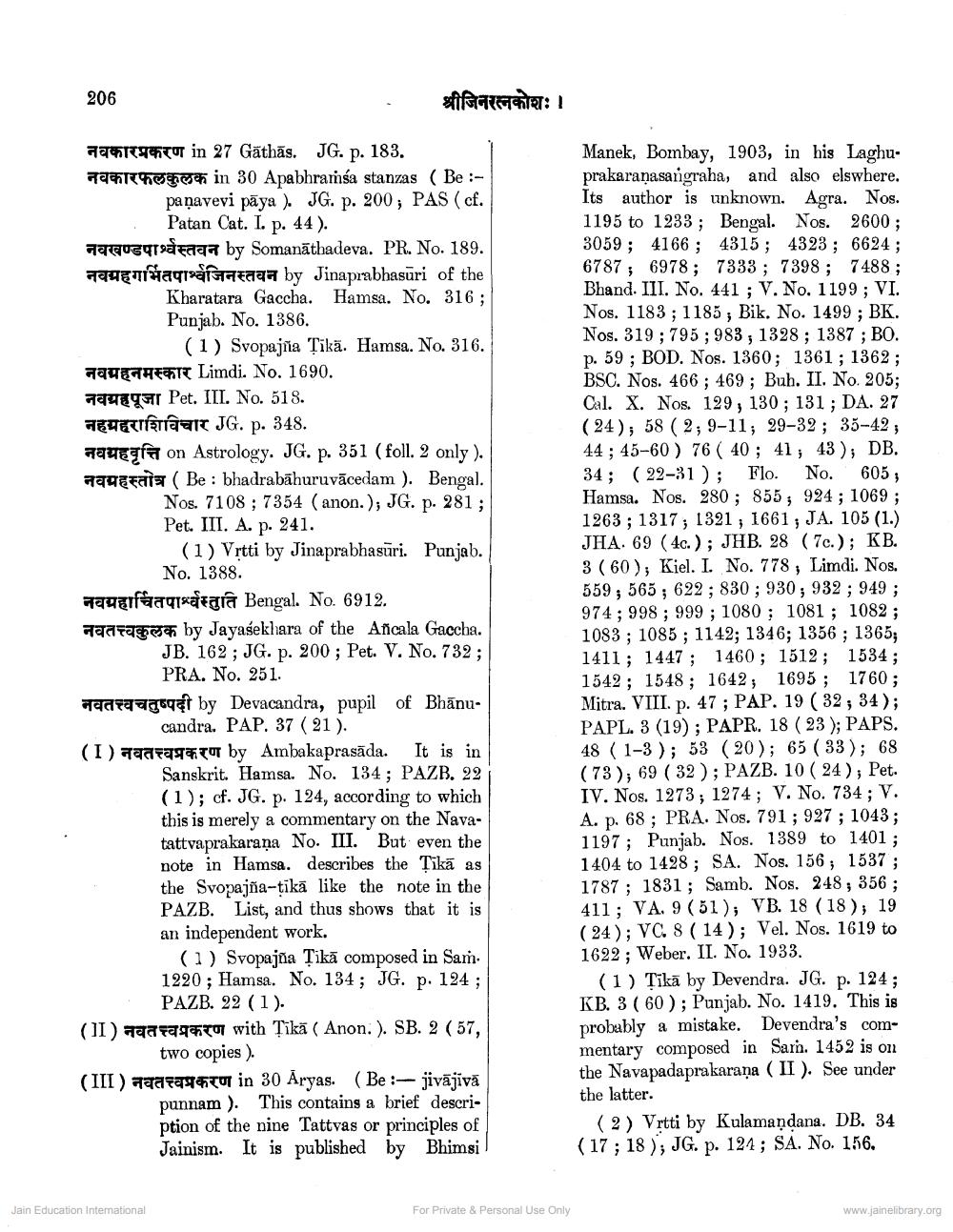________________
206
श्रीजिनरत्नकोशः।
ac t or in 27 Gāthās. JG. p. 183. h oh in 30 Apabhramsa stanzas (Be :
paņavevi pāya ). JG. p. 200; PAS (cf.
Patan Cat. I. p. 44). ATES Traga by Somanāthadeva. PR. No. 189. नवग्रहगर्भितपार्श्वजिनस्तवन by Jinaprabhasuri of the
Kharatara Gaccha. Hamsa. No. 316; Punjab. No. 1386.
(1) Svopajña Tikä. Hamsa. No. 316. AUTHEATT Limdi. No. 1690. queqfr Pet. III. No. 518. ALETTFETISIT JG. p. 348. AUET on Astrology. JG. p. 351 (foll. 2 only). 799EFals ( Be : bhadrabāhuruvācedam ). Bengal.
Nos. 7108 ; 7354 (anon.); JG. p. 281; Pet. III. A. p. 241.
(1) Vrtti by Jinaprabhasuri. Punjab.
No. 1388. नवग्रहार्चितपार्श्वस्तुति Bengal. No. 6912. watak by Jayasekhara of the Añcala Gaccha.
JB. 162; JG. p. 200 ; Pet. V. No. 732;
PRA. No. 251. Taaraget by Devacandra, pupil of Bhānu
candra. PAP. 37 ( 21 ). (I) aratatut by Ambakaprasāda. It is in
Sanskrit. Hamsa. No. 134; PAZB. 22 (1); cf. JG. p. 124, according to which this is merely a commentary on the Navatattvaprakarana No. III. But even the note in Hamsa. describes the Tikā as the Svopajña-tikā like the note in the PAZB. List, and thus shows that it is an independent work.
(1) Svopajña Țikā composed in Sam. 1220; Hamsa. No. 134; JG. p. 124 ;
PAZB. 22 (1). (II) gaafaqator with Țikā (Anon.). SB. 2 ( 57,
two copies ). (III) ataq Tur in 30 Aryas. (Be :- jivājivă
punnam). This contains a brief description of the nine Tattvas or principles of Jainism. It is published by Bhimsi
Manek, Bombay, 1903, in his Laghuprakaranasangraha, and also elswhere. Its author is unknown. Agra. Nos. 1195 to 1233; Bengal. Nos. 2600; 3059; 4166; 4315; 4323; 6624; 6787; 6978; 7333 ; 7398; 7488 ; Bhand. III. No. 441 ; V. No. 1199 ; VI. Nos. 1183 ; 1185; Bik. No. 1499; BK. Nos. 319; 795; 983; 1328 ; 1387 ; BO. p. 59; BOD. Nos. 1360; 1361 ; 1362; BSC. Nos. 466 ; 469; Buh. II. No 205; Cal. X. Nos. 129, 130; 131 ; DA. 27 (24); 58 ( 2; 9-11; 29-32; 35-42; 44 ; 45-60 ) 76 ( 40; 41; 43 ); DB. 34; ( 22-31 ); Flo. No. 605; Hamsa. Nos. 280; 855; 924 ; 1069; 1263 ; 1317; 1321 ; 1661, JA. 105 (1.) JHA. 69 (4c.); JHB. 28 (7c.); KB. 3 (60); Kiel. I. No. 778, Limdi. Nos. 559,565 ; 622 ; 830; 930; 932; 949 ; 974; 998 ; 999; 1080 ; 1081 ; 1082; 1083; 1085; 1142; 1346; 1356 ; 1365; 1411; 1447; 1460; 1512; 1534 ; 1542; 1548; 1642; 1695 ; 1760; Mitra. VIII. p. 47; PAP. 19 ( 32 ; 34); PAPL. 3 (19) ; PAPR. 18 ( 23 ); PAPS. 48 (1-3); 53 (20); 65 ( 33 ); 68 (73); 69 ( 32 ); PAZB. 10 ( 24), Pet. IV. Nos. 1273 ; 1274 ; V. No. 734 ; V. A. p. 68; PRA. Nos. 791 ; 927 ; 1043; 1197; Punjab. Nos. 1389 to 1401 ; 1404 to 1428 ; SA. Nos. 156; 1537 ; 1787 ; 1831; Samb. Nos. 248; 356 ; 411; VA. 9 (51); VB. 18 (18); 19 ( 24); VC. 8 ( 14 ); Vel. Nos. 1619 to 1622; Weber. II, No. 1933.
(1) Tīkā by Devendra. JG. p. 124; KB. 3 ( 60 ); Punjab. No. 1419. This is probably a mistake. Devendra's commentary composed in Sarn. 1452 is on the Navapadaprakarana (II). See under the latter.
(2) Vrtti by Kulamandana. DB. 34 (17; 18 ); JG. p. 124 ; SA. No. 156.
Jain Education International
For Private & Personal Use Only
www.jainelibrary.org




